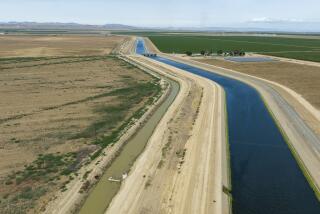Death of Rare Trout Spawns Dam Worries
- Share via
The discovery last week of a dead steelhead trout at the Freeman Diversion Dam has renewed debate over how the dam’s fish ladder is operated.
The 22-inch steelhead was found March 16 by biologists working for the United Water Conservation District.
The fish carcass was taken to Long Beach the next day for analysis by federal wildlife biologists, who found it contained thousands of eggs.
Officials aren’t sure how the fish died, but they say it was found in an area that adult steelhead do not frequent.
“The mystery is why it swam the way it did, because it came upstream and then went back downstream into an area it could have easily gotten out of,” said Jim Kentosh, the district’s manager of operations. “We don’t know why it stayed there.”
According to Kentosh and other officials, the fish negotiated the dam’s fish ladder Feb. 13 but, instead of swimming up the Santa Clara River, it turned right and went downstream, where it got caught in the district’s fish screen bay. Feb. 13 was the last time the ladder was in operation.
The bay is where young smolt are trapped and steered toward the river and away from the diversion canal.
The fish apparently lived in the bay at least three weeks before it died.
Environmentalists who have been lobbying to better protect the endangered steelhead hope the death will force water officials to reexamine their conservation efforts.
“I think it calls a few issues into question,” said Ron Bottorff, chairman of the Friends of the Santa Clara River advocacy group. “What we’re learning from this is that we don’t exactly know how to operate a fish ladder.”
District workers said they are operating the dam and ladder according to federal wildlife protection standards and that their conservation efforts have so far been successful.
Ever since the once-abundant southern steelhead was added to the endangered species list in 1997, conservationists and water officials have butted heads on how to best meet the area’s increasing water needs while protecting the now-rare fish.
For a while, fish ladders seemed to be the answer.
They gave the steelhead a way to get to their eons-old spawning grounds while allowing officials to tap numerous water resources.
Water diverted by the Freeman Diversion Dam, located on the Santa Clara River near Saticoy, irrigates the lush agricultural fields in the Oxnard Plain and is pumped into the ground to replenish area aquifers.
In 1991, district officials added a $1.5-million fish ladder that would allow the steelhead to swim upstream to spawning grounds in the Sespe and Piru creeks. It is the only operating fish ladder in Southern California.
But since then, officials have observed just six steelhead, not including the dead fish found last week, swimming upstream.
They have, however, seen hundreds of smolt--juvenile steelhead--heading downstream toward the ocean.
The dead steelhead was found in the fish screen bay, where district officials said no fish, dead or alive, has ever been found.
Since the discovery, district officials have left the fish ladder running full time and are lowering water levels in the bay once a week to check for any other errant steelhead.
However, federal officials said they may investigate the circumstances surrounding the fish’s death.
In the coming weeks, federal biologists will run a number of genetic tests on the now-frozen fish to determine whether it is wild or was spawned in a hatchery.
If it is wild, investigators from the National Marine Fisheries Service will investigate its death.
“Sounds like a lot of work, but this is what we do with endangered species,” said Brett Schneider, special agent with the fisheries service. “There aren’t many of these fish left, so every one is important.”
District officials said they would welcome an inquiry and believe every possible step has been taken in safeguarding the fish.
“My policy is to promote these [conservation] policies until the federal government says otherwise,” said district general manager Frederick Gientke. “It’s a priority for me and everyone who works for the district.”
More to Read
Sign up for Essential California
The most important California stories and recommendations in your inbox every morning.
You may occasionally receive promotional content from the Los Angeles Times.










